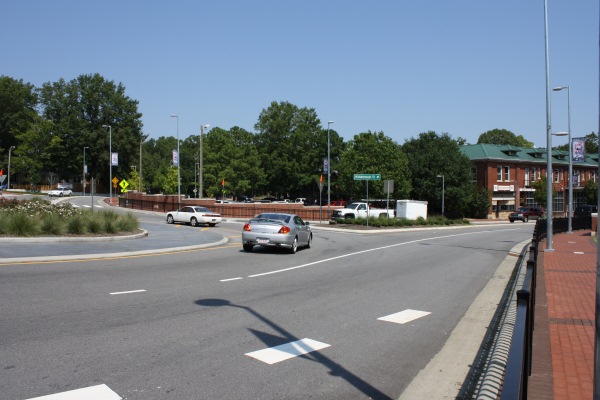Raleigh traffic engineers expected an increase in crashes when the Hillsborough and Pullen roundabout opened last year. But, the steady increase they saw was alarming, prompting an investigation into ways to make the intersection safer.
According to city documents provided to the Record, there were 60 low-severity crashes between July 1, 2010 and May 15, 2011. For comparison, there were three between December 21, 2007 and July 1, 2008, prior to the construction of the roundabout.
Senior Transportation Engineer Jed Niffenegger said that staff expected there would be a learning curve for people heading through the dual-lane roundabout for the first time. Not only is it the only of its type in Raleigh, it’s the only one in Eastern North Carolina. Add thousands of new North Carolina State University students who are young, inexperienced drivers and an increase in crashes was inevitable.
Niffenegger said the positive thing about these crashes is that no one was seriously injured. Because of the nature of a roundabout, cars are moving at low speeds, which help keep injuries and property damage at a minimum, he said.
More than half of the accidents occurred on the eastbound corner of Hillsborough Street and Pullen Street. As drivers come around the circle — from either Ferndell Lane or westbound on Hillsborough – they are colliding with cars coming eastbound on Hillsborough who don’t realize that drivers could go south onto Pullen.
“If you remove all of those crashes,” said Niffenegger. “It would be right on par with what we expected.”
Niffenegger said the increase in crashes coincides with the NC State calendar. Crashes increase when school is in session and decrease when it isn’t. But Niffenegger doesn’t know if this is due to an increase in inexperienced drivers or a general population increase.
“I would chalk this up to the complexity of the roundabout,” said Raleigh Transportation Operations Manager Mike Kennon.

What the City is Doing
Because Hillsborough Street is state-owned, the city applied – and exceeded – state standards for traffic devices like signage and markings to lessen the anticipated confusion.
Niffenegger said that when the department realized that the majority of the crashes were happening on the eastbound side of Hillsborough, they installed more flags and signage. Since that action, the crashes seem to have begun decreasing.
The city will meet with the state Department of Transportation this month and analyze the crash data from the previous year to find out if further action is required. It is possible that a capital project might be necessary. But if crashes continue to decrease with the increased signage, then the department might wait before making a decision.
Other crashes, like sideswipes, rear-ends and illegal lane changes, are due to driver irresponsibility, and can’t be fixed from an engineering standpoint.
The city has been working with NCSU to educate students about the intersection and how to safely maneuver it.
NC State’s traffic communication specialist, Christine Klein, said her department is constantly pushing out information to student groups, which then gets disseminated to the student body. Klein said they work closely with student housing, family services, new student orientation and the student media outlets such as Technician and WKNC.
Pamphlets and brochures, including diagrams of the roundabout, are sent around not only to students, but to the staff as well, she said.
Raleigh and Roundabouts
Still, the crash data doesn’t mean Raleigh won’t be using roundabouts in the future. City officials are planning to build another on the western end of Hillsborough Street.
While roundabouts cost more to construct, Transportation Manager Eric Lamb said they are cheaper to maintain than traffic signals, which can cost between $3,000 and $4,000 per signal per month for electricity and maintenance.
Lamb said roundabouts are also safer than traditional intersections. Roundabouts eliminate left turns, which can result in a severe “T-bone” accidents. They also force cars to move more slowly through the intersection, which keeps the severity of the crash low, as seen with the accidents on Hillsborough Street. If someone runs a red light, the result could be catastrophic, Lamb said.
They are also safer for pedestrians and are more aesthetically pleasing, Lamb said.
Roundabouts aren’t perfect, however. They can be dangerous for blind people, who use auditory cues to cross the street. Roundabouts do not have these auditory cues, such as the sound of a car stopping, or the chirps and whistles of a crosswalk.
Lamb said that there has been increased interest from residents for a roundabout at the Five-Points intersection, but there are no plans to install one.
